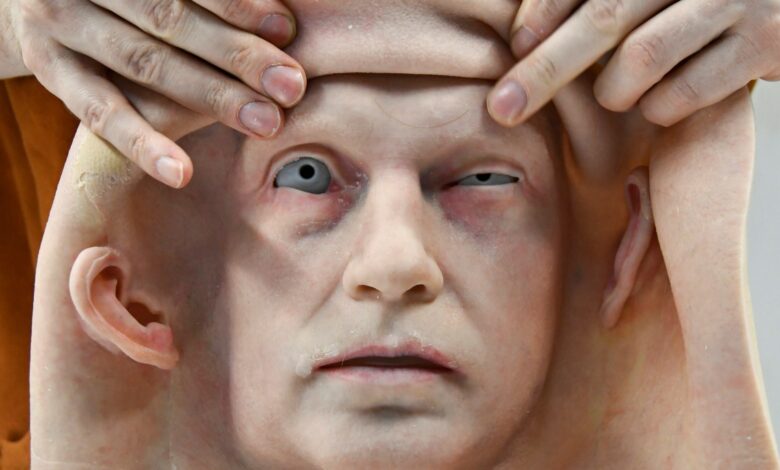Uncanny valley: What’s the latest TikTok makeup trend?

Pasty skin, empty eyes and slightly misshapen features against delirious music tracks – it’s the recent TikTok trend with a dose of disconcerting strangeness.
Generally called the uncanny valley makeup trend, it involves creators using makeup to appear as hyper-realistic bots. Some of the videos under this trend have received up to 13 million likes on the platform.
I love the uncanny valley makeup trend because it taps into the primal fear of being stalked by a not-quite-human thing that’s ambiguously threatening. Modern thrillers often confuse surprise with fear: Lingering creepiness is much scarier than one-time jump scares and CGIs. pic.twitter.com/tbpUEt6c8O
— Sherry (@SchrodingrsBrat) November 23, 2023
Pop culture has long assigned fear factors and untrustworthiness to robots, from Terminator in 1984, to Ex Machina in 2014. But today, the line between what’s real and what isn’t is increasing in a world of AI deep fakes and social humanoid robots.
Here is what we know about the trend.
What is the uncanny valley?
The uncanny valley is the state of discomfort that we enter when we see something that is very human-like, but not quite.
Many people like seeing artificial objects become more and more human-like — such as Disney’s WALL-E or C3PO from Star Wars.
But what happens when they start looking too human, something’s not quite right and we can’t identify it. Then, science shows, a deep sense of unease is triggered in the brain.
The most common objects that trigger the uncanny valley are humanoid robots. However, computer graphics in video games and films have also evoked feelings of unease within audiences.
For example, the original musical film Cats, released in 1998 and famous for its melodic track, Memory, was widely loved by audiences. On the other hand, the new version, released in 2019, drew criticism for its graphics that were described as disturbing. This is because in the original version, the characters clearly look like humans in costumes. However, in the second version, extensive visual editing makes the human actors look like animals with a human resemblance.
The uncanny valley is not only felt when there is something wrong with how a character physically looks, but is also influenced by the character’s movements and expressions. “You can produce a still that is remarkably human but you can animate it badly and it would be creepy,” Mike Seymour from the University of Sydney, who has researched photoreal faces, digital humans and the uncanny valley, told Al Jazeera.
Why do we find some robots so scary?
Through history, researchers have speculated on a few different reasons why looking at some hyper realistic robots makes our skin crawl.
Danger avoidance and mortality salience are among a few other explanations, speculated research published in 2010 by the Konrad Lorenz Institute for Evolution and Cognition Research.
Danger avoidance in humans comes from their fear of corpses. Humans have evolved to avoid fresh corpses in order to avoid the illnesses or toxins that killed them. The resemblance of humanoid robots to dead or decomposing human corpses offers a possible explanation to the uncanny valley effect. Mortality salience is knowing that death is inevitable. Human computer interaction researcher Karl F Macdorman’s research suggests that uncanny looking androids are disturbing because they elicit a fear of death within the person viewing them.
Seymour added that an explanation for the feeling is rooted in how we are neurologically hardwired. “The brain specifically processes faces and humans in a particular way,” he said. He talked about the Thatcher effect as an example, which is a phenomenon where it is hard to detect feature changes in upside-down faces. If the eyes and lips of a portrait are flipped upside down and the picture is also inverted, we can barely tell a difference. But when the picture remains upright, the incongruity becomes unnerving. “The brain warns you that something is wrong or you’re in danger.”
Where did the concept of uncanny valley originate from?
The idea of the uncanny valley was first introduced by Masahiro Mori in 1970. Mori was a professor of engineering at Tokyo Institute of Technology in Japan when he wrote an essay introducing the concept, published in a Japanese journal called Energy.
Growing up, Mori thought wax figures looked creepy. When prosthetic hands started being developed, he felt similar. Hence, the uncanny valley theory sprung from his own intuition. Since then, some research has deduced possible links between the realism of robots and feelings of discomfort.
Why is it called that?
Mori accompanied his theory with a graph plotting affinity, which is how fond we are of an object, to human likeness.
The graph shows affinity rise with human likeness until it reaches a peak and then rapidly drops, only to rise again as human likeness approaches 100 percent. This forms a valley shaped dip in the graph, lending the phenomenon its name.
Are we over the uncanny valley?
What’s noteworthy about the uncanny valley makeup videos is that some viewers remain unfazed and unterrified, speculating in TikTok comments whether we are collectively getting over the uncanny valley as we see more and more robots and characters.
In 2021, Seymour, along with a team of technology and AI researchers, conducted a field study. In this study, participants were made to interact with human-realistic avatars. The participants reported positive experiences. This potentially suggests that we have crossed the uncanny valley.
While Seymour does agree that people are much more familiar with characters due to their exposure to video games and computer graphics, it might not be the primary reason why we are possibly past the uncanny valley. He attributes the lack of discomfort with technological improvements and better graphics, such as the advancements in “simulating light and the way light reacts with skin”. He added that there has been a move away from traditional computer graphics and towards machine learning, which trains on actual human expressions to infer expressions. He renders this a “huge jump in realism that many people didn’t anticipate”.
Seymour said that the concerns associated with “digital humans” are less about the uncanny valley and more about societal and legal concerns about how the images are generated.



